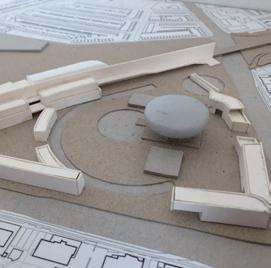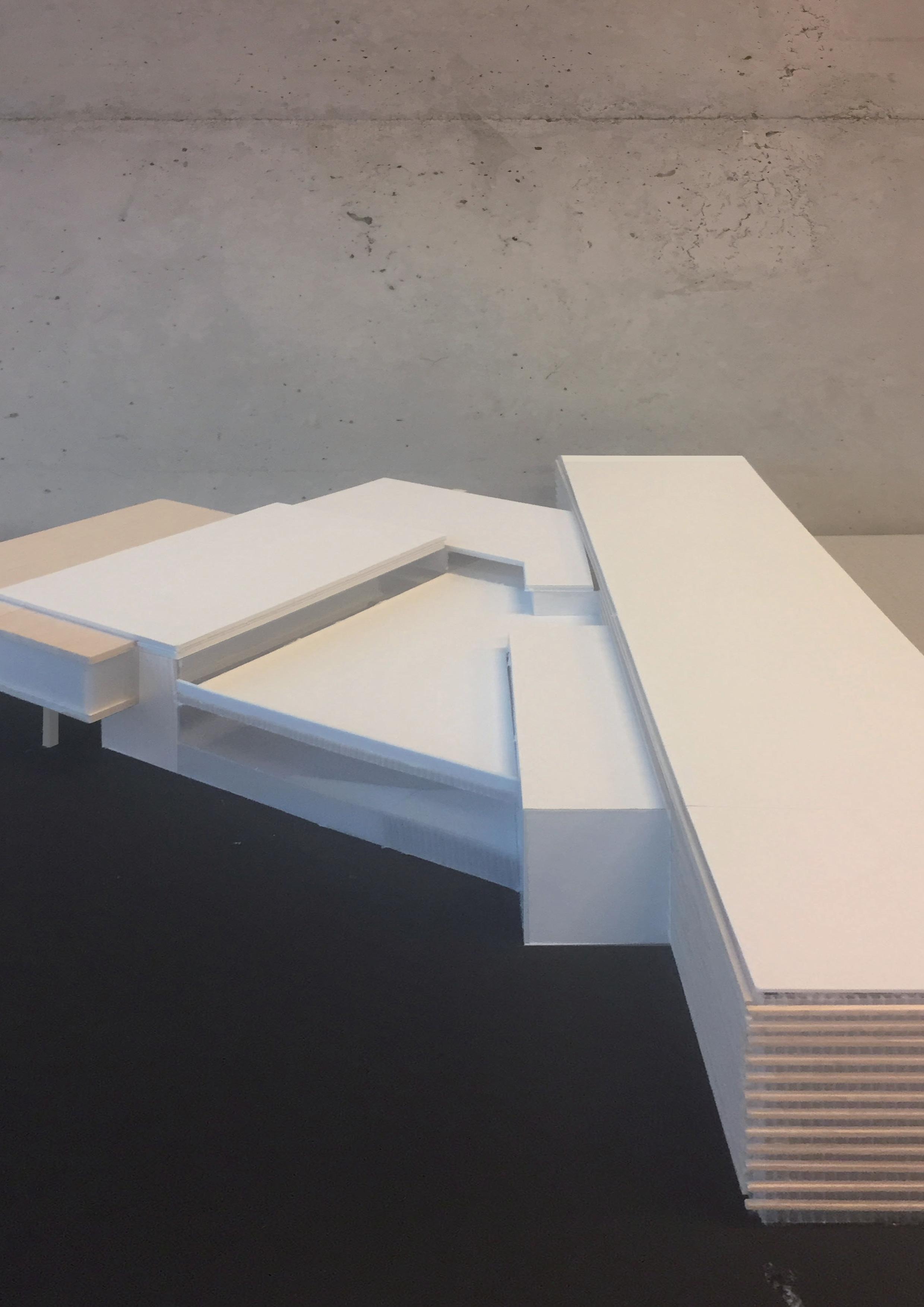
Memo Betreft Letter of Reference / Recommendation
Onderwerp Hsuan-Lin Lu
Van Steven van der Heijden
Datum 28 februari 2023
Pagina 1 van 1
To whom it may concern,
Hsuan-Lin was a trainee at Koen van Velsen architects for six months, from September 2022 to February 2023. During that period and working on a variety of projects, Hsuan-Lin has shown great adaptability to our way of working, in terms of our design programs and our drawing standards as well as our way of working together.
During her time at Koen van Velsen architects, Hsuan-Lin displayed a pro-active, hardworking and meticulous attitude whilst working on the various assignments she was given. In addition she has proven to be an enthusiastic, friendly and social addition to our office.
Before joining Koen van Velsen architects, Hsuan-Lin worked with several software packages that are not commonly used at our office. However, she managed to get herself familiar with Revit and AutoCAD by drawing presentation drawings for our Huis op Zuid project, a hybrid new-built building containing a sports centre, residential apartments and commercial spaces. Hsuan-Lin learned fast by solving every problem she encountered in the process. As the project was developed and constructed as two related, but separate projects, the work not only included working to our drawing standards but also comprised the integration of two projects of the same scale and comparable level of information. In addition to Huis op Zuid, Hsuan-Lin worked on our Groningen Station project and several other projects. She has proven herself to be fast in getting acquainted with long-running projects. I should also mention that most of our files are named in Dutch. Hsuan-Lin completed her assignments within time and of the required quality.
We wish Hsuan-Lin the best of success in her future endeavours. Due to her attitude and talent, we have every confidence she will fulfill her potential and will successfully continue her career in becoming and working as an architect.
I am therefore pleased to recommend Hsuan-Lin for position of architectural designer or junior architect at your firm.
Yours faithfully,
 Steven van der Heijden
Steven van der Heijden
Hsuan-Lin Lu

+31 619722907
hsuanlin.lu.work@gmail.com
3512 AP Utrecht (Open to Relocation)
Education
2019 - 2021 Eindhoven University of Technology Eindhoven, NL
MSc, Master Architecture, Building and Planning
- Architect Register Track
- Master thesis on hypermodern architecture(8.0/10.0)
- Seminar Emerging Technologies in Timber Architecture
2017 - 2018 National Chiao Tung University Hsinchu, TW
Graduate Institute of Architecture
- Architecture Studio I, II, III
2012 - 2017 National Cheng Kung University Tainan, TW
BSc, Bachelor Industrial Design
- Minor in architecture
- GPA3.7, Rank 1st among 45 graduates
- Dean's Best Design Award, Lexus Special Award
Experience
Sep 2022 —
Feb 2023
Koen van Velsen Architecten Hilversum, NL
Architecture Trainee
- Tiling proposals for the sports center of Huis op Zuid
- Presentation drawings for Huis op Zuid
- Wayfinding elements and lighting fixtures booklet for Hoofdstation Groningen
Language
Mandarin : Native
English : Proficient(TOEFL iBT 99)
Dutch : Beginner(CEF A1-A2)
Currently attending the A2 Dutch course
Publication
2021 Master thesis BEHIND THE SCREEN (Individual)
2021 Studio Booklet CREEPING INTO A NEW ERA
2016 Graduation Book DEEP SENSE (Collective)
Technical Skill
3D Softwares
Rhinoceros
Grasshopper
Revit
Vray
Enscape
Solidworks
Keyshot
Jul - Aug 2022
Bio Architecture Formosana Taipei, TW
Architecture Intern
- Concept diagram for Kinmen County Central Library and Art Museum competition
- Model making for Taipei Music Library competition
- Facade design proposals for Asia Silicon Valley
2D Softwares
Indesign Photoshop Illustrator
Autocad
Jan - Jun 2017
Coding Art Tainan, Taiwan
Assistant Product Designer
- Worked on design proposals for industrial air purifiers
Laser Cutting
LaserCut
3D Printing
Aug - Sep 2015
Hers Design Osaka, Japan
Product Design Intern
- Worked on a social design proposal
- Assisted with package design for stationery
Cura
Video Editting
Affect Effects








01_ Huis op Zuid
Residential Building + Sports Center
Execution Phase. Rotterdam, 2022-2023
In charged of _ publication drawings (situation, plans, sections) and detailings







19
20 20 20
16 17 18
15
Plattegrond Neveau 2 / Plan 2F 04 05
10 11
13 14
11 11 09
09
12
C C
F F A B
18 21 24
Plattegrond Neveau -1 / Plan -1F
/ Roof View Plattegrond Neveau 12 / Plan 12F Plattegrond Neveau 6 / Plan 6F Plattegrond Neveau 3 / Plan 3F 06 07 08







D E D E





Doorsnede AA / Section AA
Doorsnede DD / Section DD
Doorsnede BB / Section BB

Doorsnede EE / Section EE


Doorsnede CC / Section CC

Doorsnede FF / Section FF


Overzicht laag 0 (P0)
02_ Hoofdstation Groningen
Train Station Renovation
1896 & 1928 Kappen West Schaal 1:400
Execution Phase, Groningen, 2022-2023
In charged of_Booklet Wayfinding Elements and Lighting Fixtures, Fragment Drawings for the Commercial Signages
Wayfinding Elements P0 Overview
Wayfinding Element Fragment
Wayfinding Element Fragment




03_ Asian Sillicon Valley Data Center
Execution Phase, Taoyuan
In charged of_parametric perforated facade design proposals







Proposal 1_Noises
Proposal 2_Horizontal Signals
Proposal 3_Vertical Signals
Fragment East Side
Fragment East Side
Fragment East Side
Fragment East Side














04_ Huashan Creative Park
Office Renovation



Sketch Design Phase, Taipei
In charged of_interior modeling and rendering
05_ Behind the Screen
Video Game Museum. Architecture of Liquid Surveillance
Graduation Studio Intermediate Space, Amsterdam, 2021

The graduation studio Intermediate Space aspires to investigate the role of architecture and urbanism in the hypermodern age. With the framework of hypermodernity underpinned, a wide scope of topics are encouraged to explore, including transparency, technology, and surveillance. During group research phase, a focus onto the phenomenon of data surveillance was gradually generated.
While a panopticon was an iconic design to execuate panoptic surveillance and was later appropriated as a metaphor to control society, what can be a new design and a metaphor about surveillance in a hypermodern society?
This thesis seeks to propose an architectural design as an answer to the above question. Given with the name Behind the Screen, this thesis project is designed as an analogy to arouse people's awareness to data surveillance in the hypermodern society.
Approaching the museum from the inland side
A statue-like building composite resides on the new piece of land. The strip and circular openings raise people's curiosity to look inside the building by revealing partial exhibition contents.



Approaching the museum from the costal side
The uplifted volumes make the building composite seems like a watching machine. Ramps in between the volumns create a swirl entrance and welcome visitors to enter the entangled world.
View from IJ river
The adoption of glass makes the ramps visually lighter. The transparency also results in visible data surveillance and a perceivable sense of liminality, rendering the circular space a heterotopic digital panopticon.
Liminality
In Don Delillo's novel Cosmopolis, liminal spaces are introduced in the contemporary urban context. Because of the contrast and entanglement of the the physical environment and the virtual space, constant oscillations between the real and the virtual have become part of the citizens' daily lives. A sense of threshold is empirically perceived through bodily movements between these two urban dimensions, that is, entering one by leaving another. Given that the drastic transformations on spaces that an individual interacts with, this sense of threshold, or liminality, is a consequent status where an individual is sensitive to sensations and has a clear awareness of self and otherness.
A Liminal Space in the Netherlands
From the text, it is infered that a liminal space appears on a boundary of two domains. After comparing several topographical boundaries, a harbor waterfront is considered as a suitable choice for its strong liminality. Therefore, the filters of both a cosmopolis and a harbor are applied to find out a site in the Netherlands. As a result, port of Amsterdam and port of Rotterdam are selected and analyzed:






IJ river is like a separation in Amsterdam's context because the adjacent central station locates with its back towards the IJ river. There is not much land for people who exit the central station at the IJ river side to move forward. The clarity of the topographical boundary results in a strong liminality.
Nieuwe Maas river is more like a connection in Rotterdam's context because the bridges across the river serve as the continuous routes to transport people between north and south. The smooth moving without waiting and transitioning renders less liminality to this land-and-water boundary.
Site searching area around IJ river
It is decided to focus on the periphery of IJ river and to search for a liminal space. Attention is especially paid to fragmented terrains and pennisulas because of their extreme proximity to water and consequent stronger liminality.















View to the server atrium
A sunken data center allows visitors to look down into the space. The higher position provides visitors a sense of superiority and renders the watching act as surveillance. Servers inside the atrium are a manifest that the exhibition is virtual-based.

View to the demo atrium

Building of the permenant exhibition
On the ramps
The ramps are designed to connect the two buildings from different levels so both vertical and horizontal movement are included. The height difference and surrounding views lead to an interesting walking experience.


View to the outward cityscape
While walking on the ramps, there are views to the city, by which a contemplation on data surveillance and an association to the field of daily lives can be

The data tower

Building of the temporary exhibition
Unlike the integrated and transparent space in the permanent hall, spaces in the temporary hall are separated. As a result, there is no clear overview and the visible range is much smaller.

Arriving the entrance plaza

06_ The Wall
Collective Housing Complex / Walls' spatial interpretation
Masterproject Studio The Wall. Eindhoven, 2020
Positioned as a research and design studio, THE WALL starts with studying on wall-related projects: Barcelona Pavilion, Kilometro Rosso, and Village Project are analyzed in terms of their relation to walls and how walls in different scales can be applied in an architectural design. Literature review on WHITE WALLS, DESINGER DRESSES is carried out to further understanding the potential of walls' expressive asthetics.
After exploring the possibilities, the following design practice on walls includes both an urban design and an architectural design. Students are asked to re-design the triangular site of Evoluon in Eindhoven. A collective housing has to be designed on the site. Most important of all, walls must be readable in the overall scheme, whether as urban configuration or as architectural elements.




Case Study - Understanding how walls play their roles in the Village Project


Urban Design Perspectives
The urban design is largely inspired by the site’s surroundings.



- Walls outlining the site: residential buildings perforated by passageways (represents the passageways under the highway)

Overall Perspective
- Walls in the pond: escalators and stairs coming out from the underground parking (echoes the roundabouts in the neighborhood)
Walls can be read in several ways in this project: for example Urban-scaled walls / Architectural-scaled walls, and Space Definer / Structure.

Jacob
- Open the view to surroundings at two sides and at two corners
- Connect two areas seperated by the highway
- Perforated walls outlining the site
- Parallel walls along the highway
H-connect Interweaving Flows

- Passageway and skybridge connecting parallel walls
Keywords: subduction, border, urban stitching
Massing Development
- The curve is derived from the path in the existing context
- A skybridge above the highway
- A passageway below the highway
1. Higher, due to the required height for the basketball and tennis courts
2. Lower, for the swimming pool and spa

3. Retails under the apartments
4. At one end the skybridge becomes a protruding box overviewing the park


















07_ The Ducth Mountain











Indoor Ski Resort / Integration of multiple programs in an extra large complex Masterproject The Dutch Mountain, Nijmegen, 2020
This project is commisioned by a bunch of ski enthusiasts. The aim is to build an indoor ski resort in the area of or close to Noord Brabant. In this sense, the precise location needs to be studied and decided. Like the given name, The Dutch Mountain, it is intended to create an artificial substitute for Alpine skiing in the Netherlands. The requirement of the ski slope is restrict: both a professional and a recreational piste should be accommodated in the project. Both pistes' length should be at least 100 meters long, which renders the slope itself an extra large volume and creates enormous space underneath. Preferably, different orientations and gradients are included among the slopes. In the ski resort, with the ski slopes as its core, other programs need to be included to amuse the visitors and expedite a longer stay.

Beginner Area
Slope Gradient less than 25%
Slope Gradient from 25% to 40%

First Aid
Massing Diagrams - with a specified ski slope height of 100m











Approaching the ski complex from the parking lot
The ski park complex is consist of several scattered facility volumns. Still, all the volumes are connected by a continuous routing, which results in a closed triangle loop in the complex.
Skiing down the recreational piste
On the landing, there is an entrance to the ski club in between the two slopes. In the ski club there are the first aid, toilets, and rest areas for the skiers. Also, there is an entrance from the concert hall building, allowing people to enter and witness the skiing.


Entering the ski hall with ordinary/atheletes' routings
On the righthand side of the lobby there is the ramp for atheletes, which leads to the atheletes' training club and preparation area. Ordinary visitors need to go to the ticket counter first and then enter their preparaion area through the passage beneath the ramp.


Shopping, eating and watching the skiing practices at the ski hall lobby
On the lefthand side of the lobby there are a sport shop on the ground floor, a cafe on the first floor, a passage on the second floor connecting the hotel and the ski hall, and a restaurant plus a roof garden on the third floor. It is full of different routings and dynamics.
08_ Into the River of History
Observatory Pavilion / Spirit of Space
Architecture Studio II, Hsinchu, 2018
This project is consist of two parts: Signal Box and Signal Station. The first part is about designing a 1:1 installation with a specific construction method and with real materials. The second part is about designing a pavilion using the techniques acquired in the first part.



Context Analysis
Old Town Area and Its Boundary
The old town area of Hsinchu City is roughly surrounded by Zhongzheng, Beida, Xida, Linsen, and Shengli roads. The original city walls had been torn down and do not exist now, while part of the ancient city moat and the well-preserved East gate are still on Shengli road. The remaining ditch was expanded and renovated into an artificial river, and its surrounding area was planned and transformed into several riverbank parks.
Site Selection

-In the section of the remaining city moat
-Close to the end of the remaining city moat
Spirit of Space
-The existance of original city walls and city moat
-Linear relation to the East gate
-Waterflow and greenary of the city
Old Town Area
City Walls (not existing)
City Moat (existing)
East Gate (existing)
Spot on the City Moat
Direction towards the East Gate
Riverbank Park
Central Train Station
A cube is used to represent the no-longer existing walls and create spaces which were unreachable. Its dimension refers to the height of the walls and the depth of the moat.



The internal space is divided by two straight staircases into long and narrow aisles. Following the orthogonal routing, directionality repeatedly. They can not only walk into the bottom of the moat to feel the water flow but can also stand at look at the East gate and ponder the evolution of Hsinchu's history.










Section CC'
routing, visitors are able to sense the at the height of the city walls to
Drainage Design Detail



Material & Structure
This signal station is primarily constructed by aluminum boxes, which represent bricks used in the city walls. The aboveground structure is a column-beam system, while the underground part is designed as a hanging system.

Seeable & Unseeable
The piled-up alluminum boxes allow visitors to look at riverbank scenery at both sides. Nevertheless, the boxes block the view in the direction of the city walls. The single-directional transparency is expected to arouse people's awareness of being in the walls, which was totally solid and unreachable in its original status.









For more works, please visit www.hsuanlinlu.myportfolio.com





 Ramp House
Corridor Housing Flip House
Forest Club
Urban Form Oosterhout
Ramp House
Corridor Housing Flip House
Forest Club
Urban Form Oosterhout
